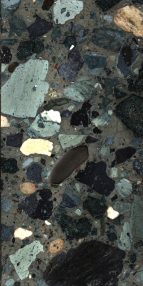Rocks Record First Day of Dino Extinction Event
November 13, 2019

When the asteroid that wiped out the dinosaurs slammed into the planet, the impact set wildfires, triggered tsunamis and blasted so much sulfur into the atmosphere that it blocked out the sun, triggering the global cooling that ultimately did in the dinos.
That’s the scenario scientists have hypothesized. Now, a new study led by The University of Texas at Austin has confirmed it by finding hard evidence in the hundreds of feet of rocks that filled the impact crater within the first 24 hours after impact.
This evidence includes bits of charcoal, jumbles of rock brought in by the tsunami’s backflow and conspicuously absent sulfur. They’re all part of a rock record that offers the most detailed look yet into the aftermath of the catastrophe that ended the Age of Dinosaurs, said Sean Gulick, a research professor at the University of Texas Institute for Geophysics at the Jackson School of Geosciences.
“It’s an expanded record of events that we were able to recover from within ground zero,” said Gulick, who led the study and co-led the 2016 International Ocean Discovery Program scientific drilling mission that retrieved the rocks from the impact site offshore of the Yucatán Peninsula.
The research was published in the Proceedings of the National Academy of Sciences on Sept. 9, 2019, and builds on earlier work led and co-led by the Jackson School that described how the crater formed and how life quickly recovered at the impact site. An international team of more than two dozen scientists contributed to this study. Most of the material that filled the crater within hours of impact was produced at the impact site or was swept in by seawater pouring back into the crater from the surrounding Gulf of Mexico. Just one day deposited about 425 feet of material — a rate that’s among the highest ever encountered in the geologic record.
Researchers found charcoal and a chemical biomarker associated with soil fungi within or just above layers of sand that shows signs of being deposited by resurging waters. This suggests that the charred landscape was pulled into the crater with the receding tsunami.
However, one of the most important takeaways is what was missing from the core samples. The area surrounding the impact crater is full of sulfur-rich rocks. But there was no sulfur in the core. That finding supports a theory that the asteroid impact vaporized the sulfurbearing minerals present at the impact site and released it into the atmosphere where it wreaked havoc on the Earth’s climate, reflecting sunlight away from the planet and causing global cooling.
Back to the Newsletter